-
Posts
3,829 -
Joined
-
Last visited
Content Type
Profiles
Forums
Gallery
Events
Posts posted by glbarlow
-
-
Having built several of your designs, I’m a big fan of your work. I know where my next kit is coming from...
- Canute, mtaylor and chris watton
-
 3
3
-
I see you also had fun, more than I did, with the “Captains Quarters.”
-
On 6/3/2015 at 4:23 PM, ASAT said:
Joe, this has got to be one of the best Granado builds on MSW. IMHO that title used to belong to Glenn Barlow but I think this build surpasses even that one - awesome joinery and building skills, great creativity in presentation and color choices but the rigging is the clincher, great job all around!!
Just saw I'd lost my title as best Granado built 😄 I still like mine, but have to agree this is a great job (I realize I'm 5 years late posting, but I've been out of modeling for a long while.)
- Ryland Craze and Canute
-
 2
2
-
-
After 4 years (with a two year break between) my journey and this log for the HMS Vanguard is complete. I'm not taking it any further, as I originally stated there are no masts and rigging to be added. I've included some final photos and hope they might offer some help for others building this model, at least what some options look like or perhaps what not to do.
As I said at the outset, this is a really big ship even at 1/ 72th scale its over 3 feet long and easily 3 times larger than my other models. I had wanted to build a 72 gun ship, I won't want to again. The Amati model is very complete all the fittings (generally at least 2 extra of any given one), plenty of the various wood, and well etched metal and wood parts. The plans are very complete, even if at times you have to look between the instructions, the extra and very helpful extra booklet on the hull and the many large plan sheets, most full scale. Everything needed in the level of detail needed is included in the kit. It's just big.
I made little attempt at historical accuracy. I put so much effort into that, including getting copies of original plans and multiple books, on my HMS Pegasus I just didn't care this time around. It's relatively accurate, I've tried in this log to call out where I went off-book. For finishing touches I attached the anchors in the same way I did on the Pegasus, so that required some minor modifications not in the plans. The hammock netting also isn't included in the plans or the kit, I picked up a yard or so of "material" from the local JoAnn's store (fabric and sewing store in the US). I had tan, white, and black and like with the Pegasus decided on the black.
The photos show I need to re-align some of it on the stern which was added months ago, and straighten a few gun tackles. Other things, such as howser rope and minor touches came from experience building past models.
So, here are a few photos to show the completed model. Its no where near as shiny as the photos make it seem, just a result of my camera flash bouncing off the paint.
It will be a long while, if ever, before I start another model. If I do it will be something completely different and smaller (like the Echo cross section). So after seven completed models I think I'm done. Building these models has certainly provide me with many hours of enjoyment, I hope it will for you as well. My log is complete.
- Kusawa2000, glennreader, coxswain and 11 others
-
 13
13
-
 1
1
-
No problem. That's the process called splining the planks. There are lots of tutorials and logs on this phase of ship building, some more complex and precise than others. I get a pretty good result from my approach to it as evidenced by the photos. I had a really detailed log on the Pegasus where I described planking in detail, unfortunately that was all lost when this site crashed several years ago. So, I've described it in some detail in this log starting on page 1 with the first planking and further on for the second planking. That process is how I get everything to fit. Its important to get the first planking on the ship, no matter how it fits, and sand it until its the shape you ultimately want (described in the log). This includes adding "cheats," balsa wood fillers between certain frames (also in the log) because its unnatural for wood to bend in 2-3 directions at once. (so soaking comes to play). The second planking is thin so while you can and should sand it smooth, you have less wood to work with. Cutting (not sanding) the shape of the planks to fit uniformly from bow to stern is a practiced skill. The Vanguard is my 7th, and final, ship. Nonetheless I had to relearn it each time. My log and others will give you the technique (as I noted I go with a simple process I learned from someone else - some people want to get much more technical with it). It takes practice (and a lot of sharp blades) to make it work so that all you have at the end is some finishing sanding.
Hopefully the beginning of the log answers your questions. You definitely want to end up with no hairline gaps. The level of accuracy varies if you're leaving it natural or painting - if your painting (and if its your first one I'd advise you to, paint covers a lot of mistakes) then wood filler (from any hardware store) also fills gaps from mistakes.
I hope that helps.
- kier and Jack-in-the-Blue
-
 1
1
-
 1
1
-
Sorry, I'm not sure what you mean by bevel? Are you referring to splining the planks, I described that in the post. I'm happy to help, but not clear on what you mean.
-
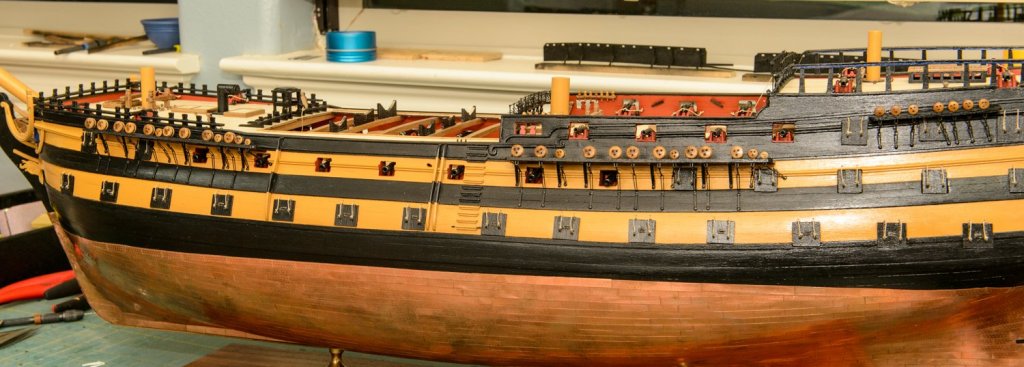 Been a while since I posted progress pics, but here goes.
Been a while since I posted progress pics, but here goes.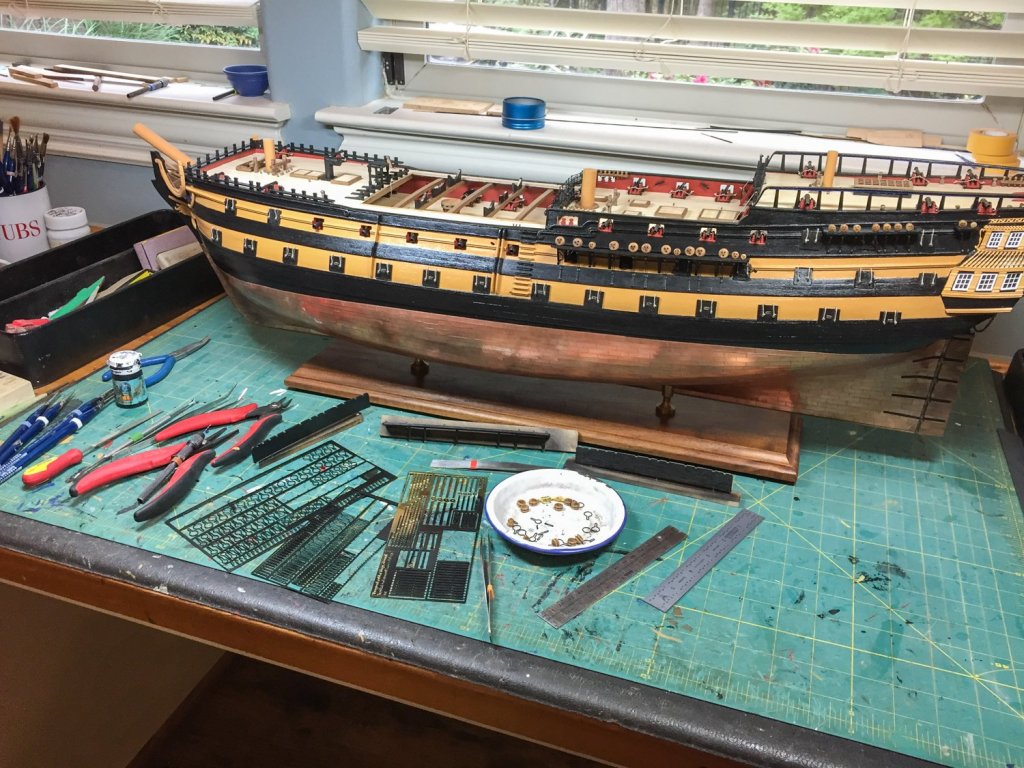
Working on the channels and deadeyes on a ship this size is all about the process. I airbrushed the etched metal pieces to start, then did the same to the channels. The little stands are made from leftover material and have come in handy to hold the channels while various stages of assembly dry and/or are painted. All the tools in the photo come into play at one step or another, reminding me of their value by making the assembly easier. The little white metal dish is the collection point for all the parts required for the channel I'm currently working on, after cutting them from the metal sheet, I file the cut edges then touch up the paint, which I have to do again once their installed, but it makes that final step easier. The smaller deadeyes on the main channel require a little finess to fit as they're close to a gun port, but otherwise there's no magic to it, just a lot of small detail work aligning and drilling the holes and finishing it up with the nails plugged into the hull. One key first step though is the initial fit of the channel onto the hull, aided and aligned by cut off nails serving as pins between the channel and the hull. The actual fit varies as you'd expect based on how I built the hull, I was surprised they came out as close as they did and required minimal sanding.
I counted just for fun, there are 97 different pieces of wood, nails, deadeyes, and etched metal required to assemble one of the two main mast channels. Progress is slow, but having a repeatable process and a series of steps helps move it along. My own little factory assembly line.
The fun continues...
-
-
I didn't have that problem with either the first or second layer, that's quite surprising. My kit is also from Amati and both layers had plenty of both woods and planks at the needed length supplied with the kit. I'd start by contacting Amati. My kit was short starboard side copper plating for some reason. I contacted Amati and now have enough to also do another ship. It took them a while to respond, but they did by sending the copper in original packaging.
-
I've taken a really long break due to some neck surgery. I don't have much left to finish on my Vanguard so I'm planning to get back to it soon to wrap it up. While I've left open the option of masting and rigging I really have no intention to do so. My seven other fully rigged models have taken up about all the shelf space I have (available for ships...my wife lives here too:-)
I see the whole site got a facelift while I was gone. Nice...
-
I've finished the 4th ship's boat, the admiral's barge. A few cosmetic changes from the plans to make it stand out a bit, but construction was no change from the previous three.
Here is is sitting alone on the ship.
And here are different views of all 4 sitting in their cradles. Not a final fit, I'll leave them off till near last so they aren't damaged as I move back to the ship to install the channels.
Glad to have these done. Initially it was a nice diversion and something very different from the months spent on the Vanguard, but truthfully by the 4th one I was looking for something new to do. Still, they turned out ok and look pretty nice on the waist of the ship.
Once the channels are done, I'll mount the boats, add the rail that goes along each inward side and the hammocks to the outer side. All the holes are pre-drilled as were the tie down eyelets installed. Its always good to plan ahead, so much easier later.
I get few comments on this log, but hopefully someday they'll help someone looking to build ship's boats.
-
Turns out I did do a bit of. A tutorial earlier in my Vanguard log, so long ago I had forgotten. http://modelshipworld.com/index.php/topic/3329-hms-vanguard-by-glenn-amativictory-models-172/page-2#entry120343 Maybe it will help.
- Canute, mtaylor and CaptainSteve
-
 3
3
-
Definitely planked and horizontal as shown in the photos above. Lesson for next model is to do that before running the side planks as they should overlap the stern pieces (as shown above). At this point you'll have to do the opposite of that, but its not that big a deal with sanding and once the hull is painted.
- mtaylor, Canute and Seventynet
-
 3
3
-
Agree. I've build a lot of ships and bent a lot of planks. Water in a glass works just fine for me.
- thibaultron, Canute, mtaylor and 1 other
-
 4
4
-
Soaking the wood works for me, doesn't have to be hot boiling water or microwave - just soak in a glass of water.
- thibaultron, CaptainSteve, mtaylor and 1 other
-
 4
4
-
I've planked a lot of hulls, right now I'm working on the 4th ship's boat for the Vanguard model I'm building (link to my Vanguard build log in my signature line show's my work on those boats, its the most recent series of entries). In a lot of ways building a ships boat is harder than the hull because of the small size.
I start with the top most plank and work my way down. However, the second plank I install is the garboard plank at the keel. You're always going to have some fill even with the most perfect planking job. You want that fill to be on the bottom where it won't be seen. However you need a neat garboard to get a good clear match to the keel.
With the top plank (below the future cap rail) done and which should require splining and the bottom plank (garboard) done at the keel I start working top down. Splining and tapering to fit is not that difficult. Determine by counting how many planks it will take to fill top to bottom at the widest point, the waist of the ship. Measure the distance top to bottom at the bow between your top and bottom plank and divide by the total planks at the waist. Example if it will take 10 5mm planks at the waist to fill and your measurement is 5mm then the plank width at the bow needs to be 2mm. Its then just learning where to start the trim based on how it overlaps and use a standard Xacto knife and a metal ruler to do the trimming. Probably have to do the same thing at the stern. The comments about the trim and curve of the garboard above are correct, but I wouldn't stress much about that, its an easy trim and at the bottom of the boat not noticeable, especially after sanding and painting the final result.
I'm sure somewhere on this forum is a more detailed explanation of planking (I had a detailed tutorial here once, but it was lost in the great site crash). But the basics of working top to bottom and trimming so that every plank full width at the waist reaches the bow at a smaller width is the way to go. The little fill that leaves at the bottom between the last full plank and the garboard won't ever be seen.
-
Proving anyone can build these things with patience, a bit of skill, and a lot of time here is the third of the four ships boats, the Pinnace. I added a tiny bit of flare to it and a color I'd never used before for trim, Caldercraft Admiralty Paints Olive Green.
While this little boat was capable of sails so the cap rail is a bit different, I kept it natural like the other two boats (and as the fourth will be) for consistency of appearance. Plus it was more challenging for me to not be able to cover up mistakes with paint which I'm really good at doing (mistakes needing covering :-). The variations from plans include flush mounting the rear bench with the side benches instead of overlapping, and the two green trim pieces for and aft which are simply 1x2 mm pieces glued in place.
Here the three are sitting temporarily on the Vanguard in their future home. The admiral's barge is the last of the four. I have the first planking on it, however work comes to a halt until after Christmas. I've got my granddaughter's doll house to assemble, clearly that is my priority.
I like how these are coming out, no way I'm going to cover up all this woodwork with a bunch of metal etched oars laying inside each boat, whimsical as it may be I've decided they are all stored below due to an impending storm.
-
Finished the cutter. This little dude was a big challenge, everything is so small and hard to hold on to. I think it was more difficult to make than the barge because of the size. Only deviation from plans was again diving into my wood stock for a thinner .5mm strip of boxwood I cut to 2mm wide and used for the wales. In my opinion the 1mm was too thick on the small boat.
These close up photos always reveal things I don't see when I'm looking at the model. I'll have to go back in with my 18/0 spotter brush and get touch up a few things.
Next up is the launch.
- kier, DaveRow, Landlubber Mike and 1 other
-
 4
4
-
I finished the barge. It was fun to build a small boat after so much time spent on the Vanguard. I think it turned out pretty well. The pillars in the center are where the cutter will eventually sit once mounted on the Vanguard. They will be completely obscured by the cutter, they are purely functional.
I have two variations from the plans:
-I used 1x4 instead of 1x2 for the rear benches, just seemed more proportional to me plus I flush mounted them instead of the plans overlap approach. I likely won't repeat either of these on the smaller boats, but I think it looks good here.
-I used 1x3 (I have lots of wood stock from previous models) on the wales instead of 1x2, the larger black wale is much more impactful on the barge.
Here its resting (not mounted, don't have the cradles on yet) in its future home aboard the Vanguard. Aside from the cradles, there are rails and hammock holders yet to be added to the ship. I did mount the boat tie-down eyelets on the beams before they were added to the ship.
With the largest boat completed for whatever reason I elected to make the smallest next, the cutter. Planking this was actually more challenging than the barge, not much room to work. It looks so tiny compared to the Vanguard. its still a work in progress, I have several more steps and touch up work before its completed.
Visible here, and also on the barge, I added a 1x2 strip on the front of the upper bench area deck to match up the two levels. Its largely hidden by the bench, but it is a visible and worthwhile addition. While this is cosmetic the next modification is significant.
The plywood floor, covered by decking strips works fine in the barge. It did not in the cutter. I found after fitting it that only about 1 mm of sideboard was left, not even enough room to mount the benches. It just wasn't going to work. I dug into my wood stock and used instead a 1/32" strip as the floor again fitted with decking strips provided with the model (which I didn't use on the Vanguard). The completed deck is 1mm thick instead of 3mm. That 2mm made a huge difference on this small boat. I may have to repeat it on the remaining two boats, I'll see when I get there.
Ultimately it will rest sitting on top of the barge. Even it seems to dwarf the cutter, I can imagine how small a couple of sailors felt rowing this thing around the Vanguard in real life.
That small strip the bow of the barge is sitting on was my practice board for cutting the rowing divots. I mentioned I was worried about this in my previous post. I found the edge side of my diamond flat file worked just fine. Just had to go slow and mark the locations and measure the depth carefully. The practice helped.
This is a good point for another shout-out for Caldercraft Admiralty paints. I like the colors and it goes on and covers so easy. I can't imagine using any other paint, though I have to order it from the UK so I order in bulk. All my work is finished with a water based poly to protect it for the long haul. The camera flash makes it more shiny than it actually shows.
I'll most likely continue with the other two boats before returning to finish up the ship. But its about time to knock off for the Christmas holidays.
-
After finishing the headrails it was time for a change of pace. Here is the start of the barge, largest of the four ship's boats to build. The supplemental book provided with the model is very helpful and clear on how to build these.
I'm using 3mm x .6mm Ash, the same I used for the deck. One because I have a large supply from Hobby Mill (sadly no longer in business) and because its easy to work with. The instructions call for 3mm x .5 strip, but I found no such wood in the kit. 3mm is the right size, anything wider would look out of scale and double planking with .5mm makes the hull plenty strong. The only thing about using thin wood like this (vs. the usual 1mm) is you can't sand your way out of bad planking to a smooth finish, or at least you have a lot less room to do it.
Hull strength is something you get to verify when you snap out the supports. I made this easier by lightly sawing both sides of the support at the base of the "U" I didn't take a photo before removing them but the instructions photo is clear. Still sanding to do on the inside.
As I often do, I ignored the instructions. In this case I didn't glue in the deck support, doing this made planking it outside the boat very easy, quick, and neat. By being able to remove the deck, it will be much easier to add the ribs and thwarts as well as paint the inside. I can do all that then finish by gluing the deck into the finished product.
It had been so long since I planked the ship I had to re-teach myself how to spline. I'm thinking this is going to be harder, not easier, the smaller the boat gets, so I'm glad I started with the largest boat first as the instructions suggest. Kinda fun working on this small scale after so long on the huge ship. I'm not sure I'll enjoy notching out the rowing slots (the instructions show the photo, but not a good way for doing it) for the eight sides I'll eventually need, I'll have to figure out some way to do this simply and easy to repeat.
- Ryland Craze, DaveRow and mort stoll
-
 3
3
-
It's a pretty standard on metal etchings like that design to paint the flat parts to match its location and the raised points to stand out, including the flat metal surrounding is the only way they can manufacture such a small ornate part without it breaking apart.
My point about heavy is driven by the fact I won't be rigging the bowsprit as you've done in your model.
I am thinking about perhaps adding some French Blue into the bow area, but I'll decide that later. I think you may have gone a bit too black on your main headrails, its getting lost in the rigging. I on the other hand I may be going a bit to yellow ochre.
I do like how you tied the metal decorative piece into the cathead.
-
I always included in-progress photos in my long lost detailed Pegasus build log and noticed I’d done it to a lesser extent in this log before my two-year break. I thought I’d offer that again for the head rails portion of the Vanguard. Mostly because while the directions are helpful in showing where things fit, they don’t help much with the actual work. I’ve included a photo of the tools I used, all of them to one extent or another were used just for the headrails.
The 6 metal decorative strips required for the headrail assembly have to be bent in multiple directions, for those fitting into the headrail frames, 4 changes of direction are required. Pliers can’t be used on the soft metal (as I discovered as I threw away the first attempt), it’s a lot of finger strength. Wrapping the metal in multiple layers of a cotton cloth and lightly using the pilers with the cloth buffer helps for the more difficult turns, but it’s important to keep a flow to the pieces, not sharp bends and turns. It’s just a series of trial and error until finally a fit of the right length and form to lay curved naturally on the hull, into the channels of the frames, and finally onto the stem.
What I learned is preparation is everything. Take the time to make the channels in the headrail frames deep enough for the metal trim – this avoids having to file the metal later. Also make sure the angle and slope of the channels go flow with the metal, so as to not force awkward bends to get a fit. I again found myself doing a lot of trimming to the small forward frame for this to happen. Also remember it’s a fragile area and hard to get a grip – I can attest to this by the break shown in the photo of the topside wooden grid – fortunately I can go back and fix it, but I came close to disaster more than once forgetting what I was holding onto while fitting the metal.
I don’t have a perfect match on the lowest stem piece. I could trim it and may yet, but right now I think it looks better as it is than if trimmed down. This is an example of what else I learned. I don’t recommend following the order in the instructions. I fitted both of these pieces properly, if they were by themselves, but when it came to matching them up I couldn’t do it in a satisfactory way (beveling the one piece on the hull or having the piece on the stem mounted lower, but not aligned with the hawse holes). Had I not already installed the stem piece first I could have adjusted. As it was, after it was installed it was too late. I maybe could have torn it all off and likely remade pieces, but just not that big a deal to warrant the work. Wood filler of course would just look sloppy.
So my order was stem pieces, hawse hole assembly, cheeks, frames (after ensuring the trim fit in the channel off the model). metal pieces on the frames, main headrail piece, cathead (aligned to main headrail), final metal hull decoration piece aligned to cathead. This worked for me other than that bottom stem piece as noted above, which I could have solved with more testing and dry-fitting.
Other notes:
I chose not to cut into the larger yellow rail in fitting the cathead. Mine is pretty tall, it would look sloppy to cut that rail down to the hull as I did the two black hull rails above. So I trimmed the cathead support piece to fit as its shown and ended the metal decoration piece into the yellow rail. From a normal viewing distance, it looks good to me.
I chose a gentler curve for that same decoration piece, just aesthetics, to me a sharper U shape wasn’t to my liking.
As you can see, to make the main headrail less two dimensional I fitted a metal decorative piece on top – I like the look, ties it altogether for me.
A big change I made: I used a 3mm x .5 wood strip to cross over the metal pieces on the frame. I highly recommend this. I did it for two reasons; the recommended 1mm thick piece looked heavy (see below) and I liked how I could fit the end into the gap between the stem piece and headrail frame and how it curved into place at the top. Frankly it was just easier and is a nice look.
I considered painting those strips French blue, but elected not to. I like the all yellow ochre look (plus despite the photo on the box cover it’s what the directions call for).
There is also a decorative metal insignia/decoration that fits on the stem, again I may not add for the ‘too heavy” reason. I’ll decide later.
So what’s this “too heavy” thing? As I’ve noted I’m not adding mast and riggings to this model. Without all the rigging that goes with the bowsprit to offset, I need to balance the model a bit.
This whole model is a therapeutic exercise for me. Based on past models I know I have the skills to build and I like sharing information to help others learning the craft, so I hope this helps others a bit. While I don't worry about changes I make from a historical perspective, I do all I can to make my work crisp.
- Jack-in-the-Blue, kier, mort stoll and 1 other
-
 4
4
-
I've always done my rigging first standing then running and both of those center outwards driven more by the belay point than the line itself. It gets really tight at the end no matter what, I learned to belay lines with tools. My favorite is a 3mm dowel with a large eye needle glued into the end and the end of the eye cut off making a two pronged pitchfork. With that I can guide the lines onto the belay point.




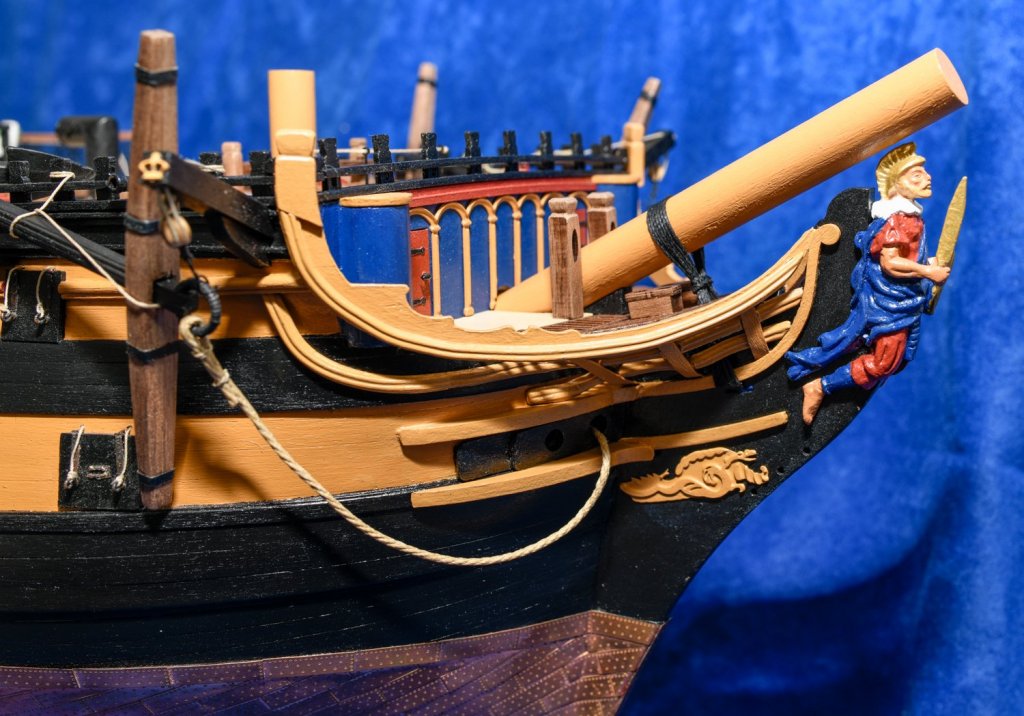
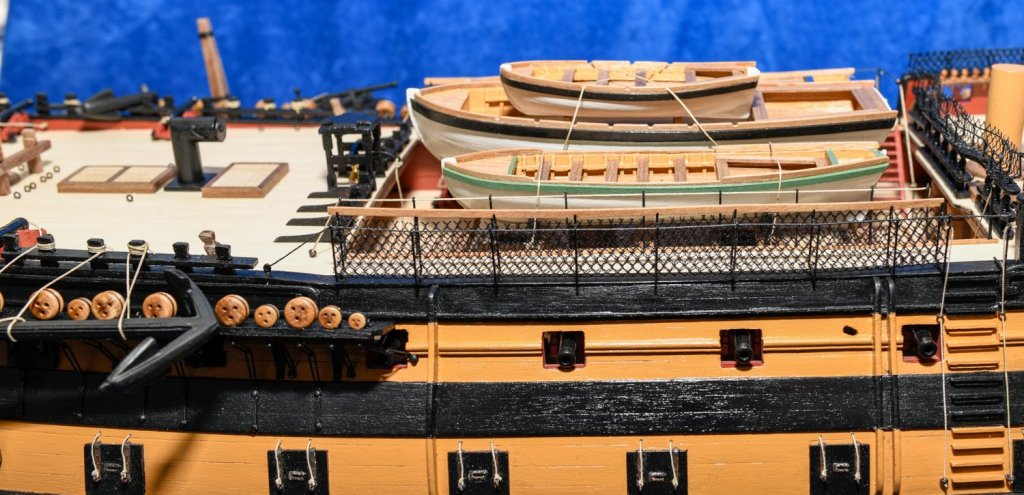
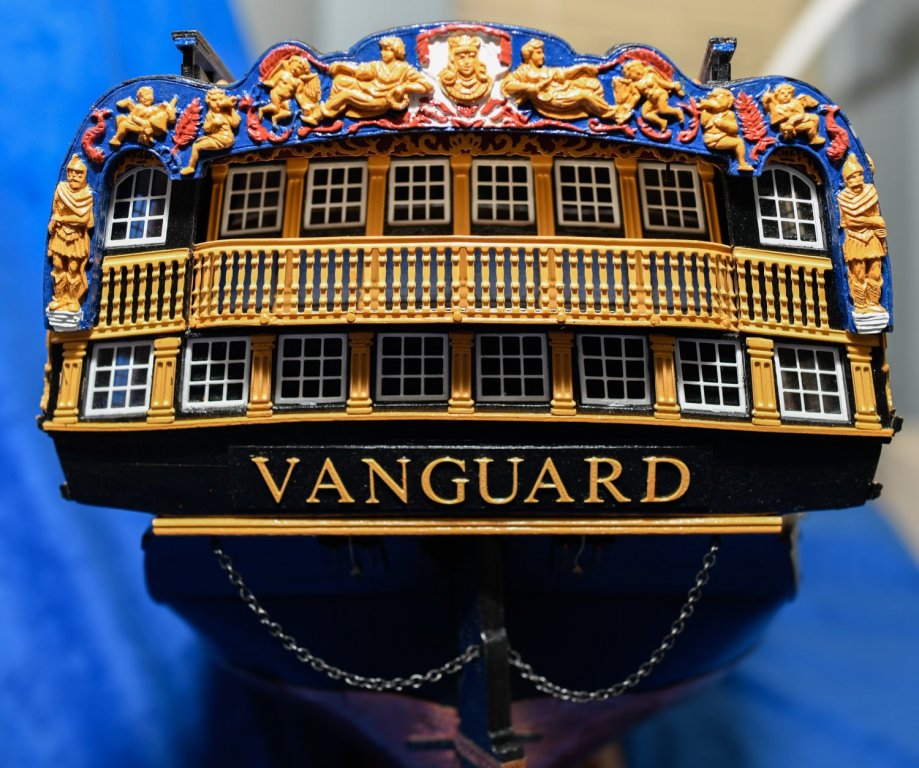
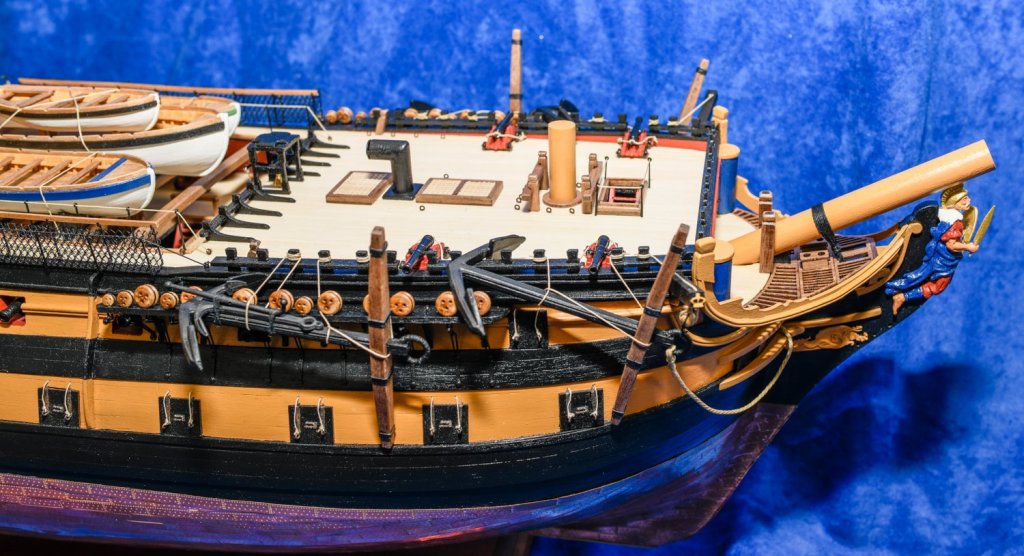
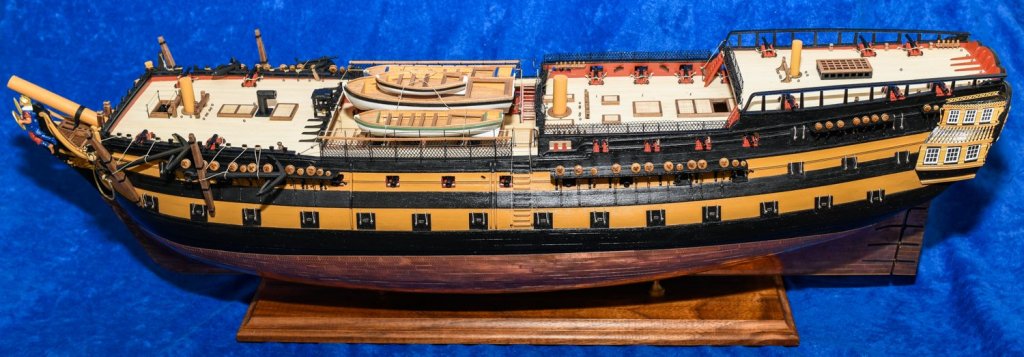
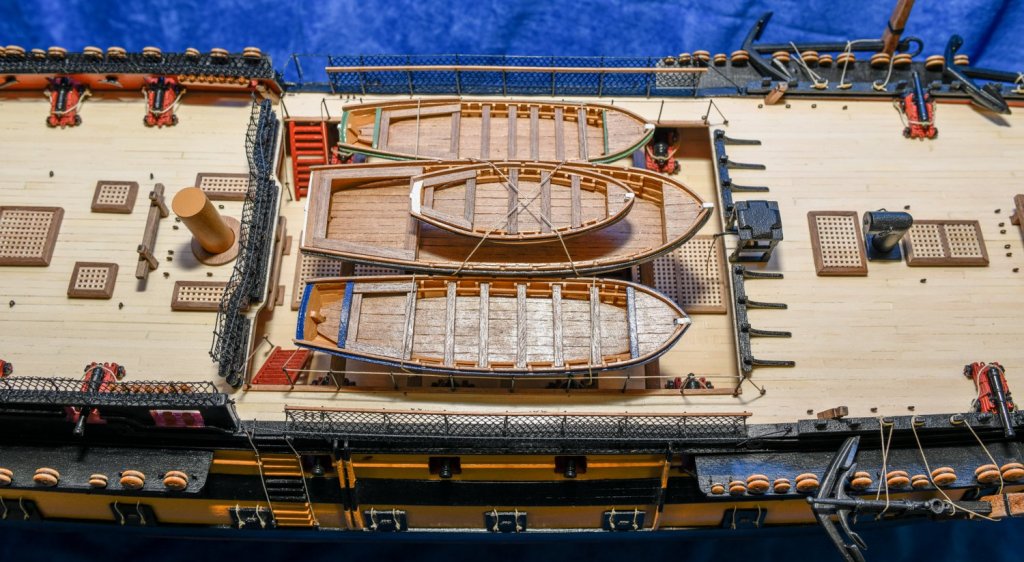
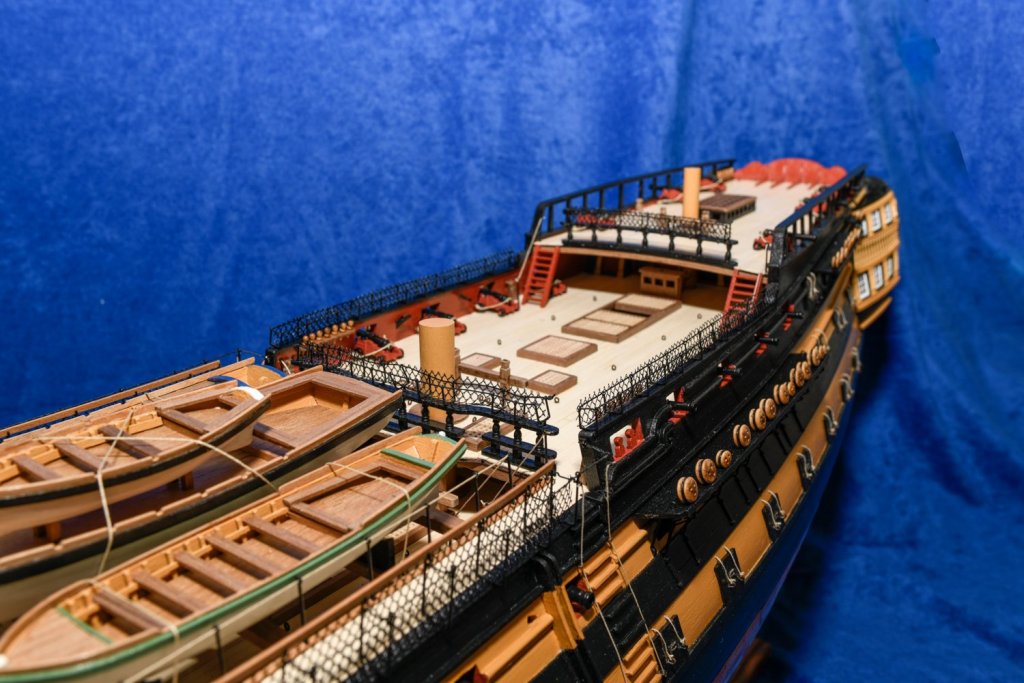
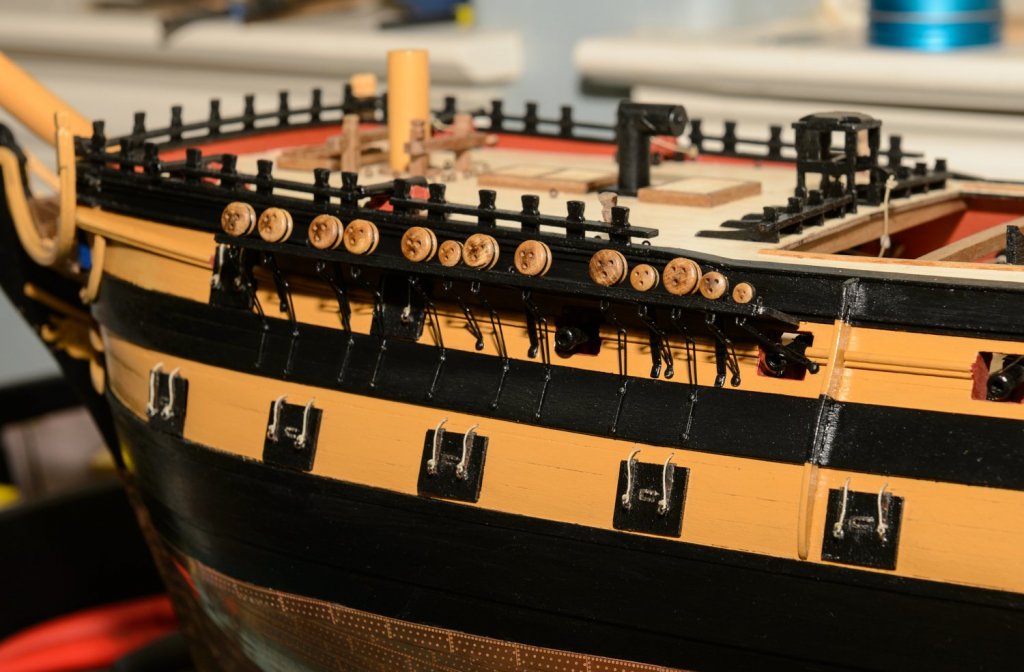
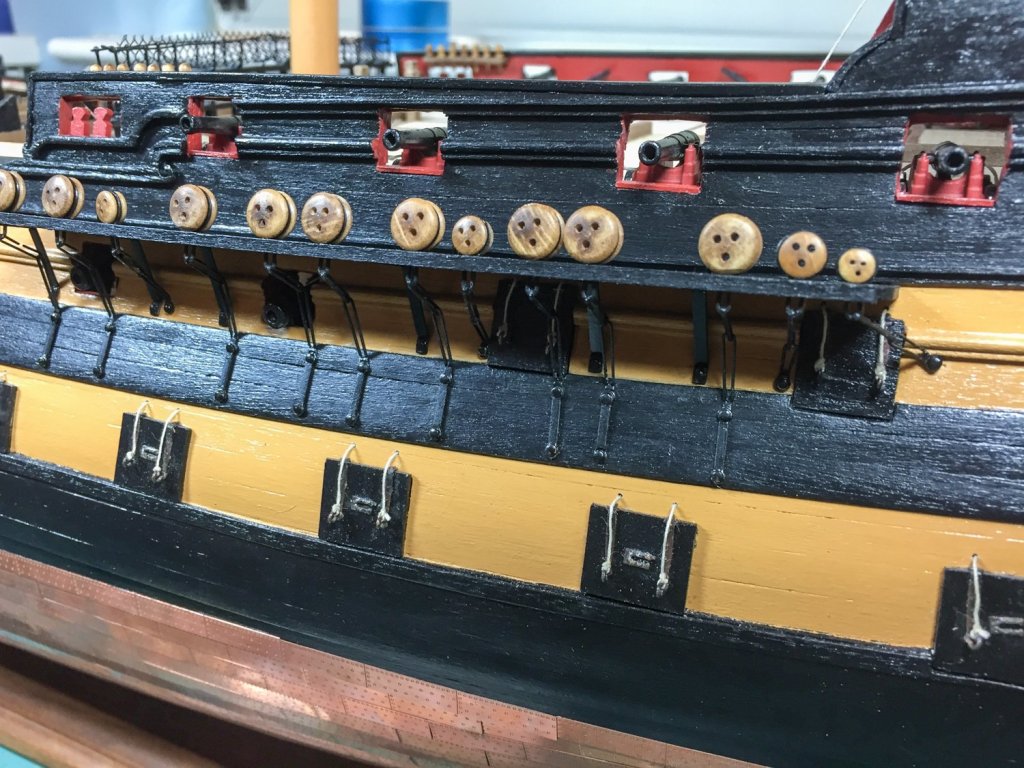
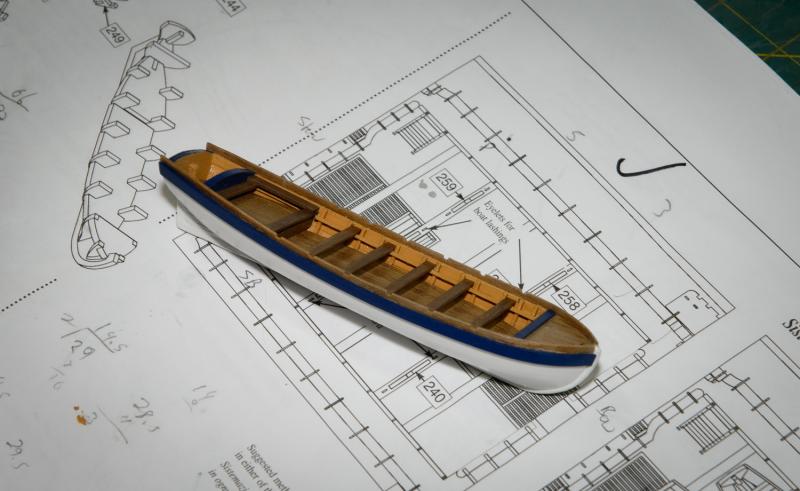

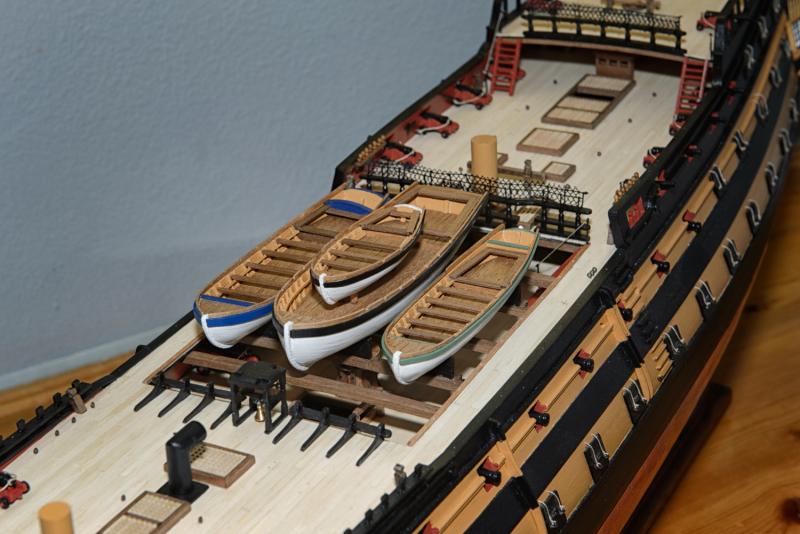
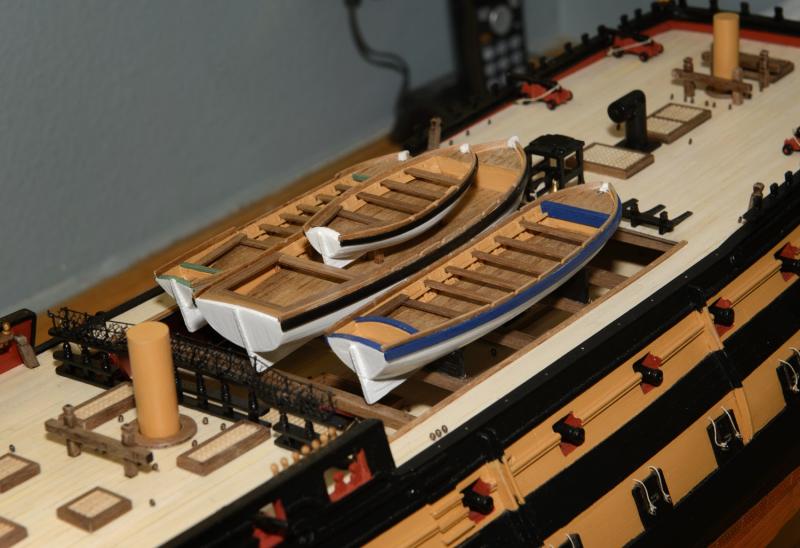
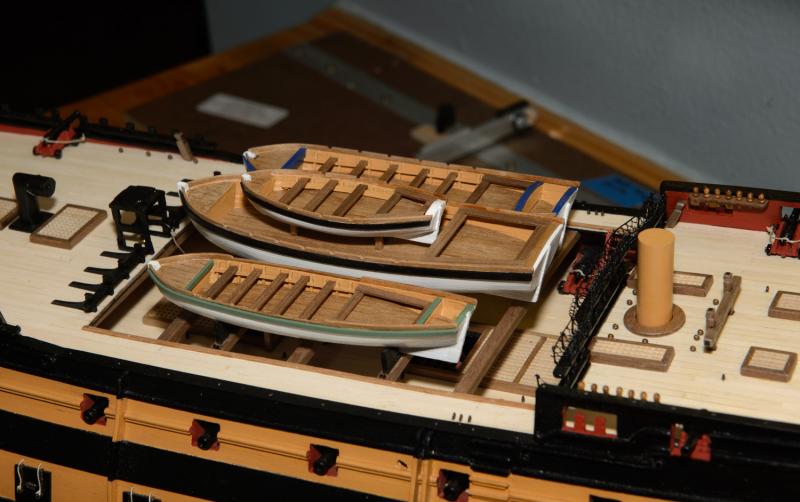
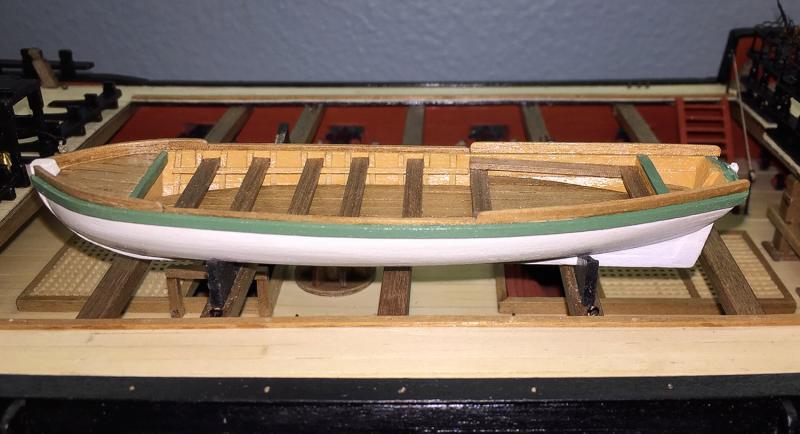
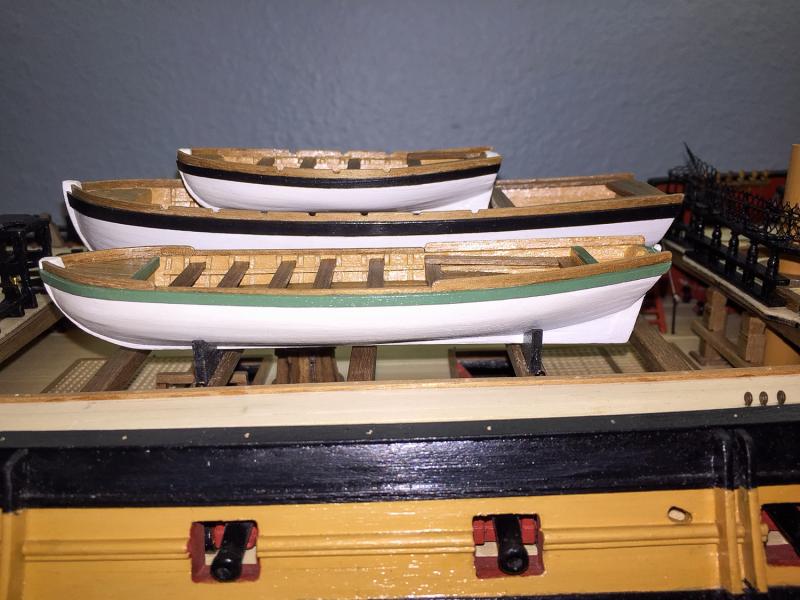
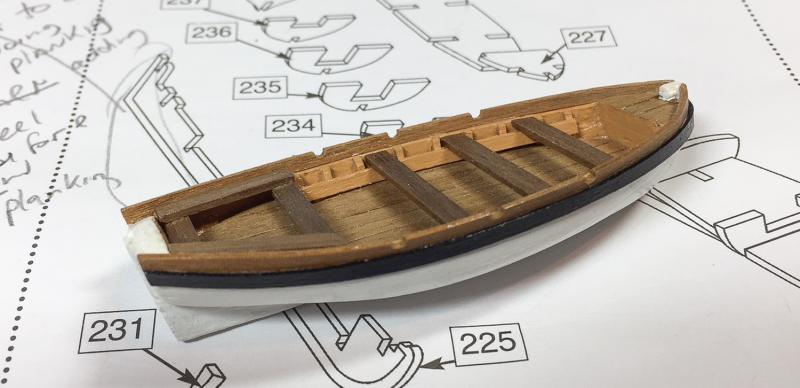
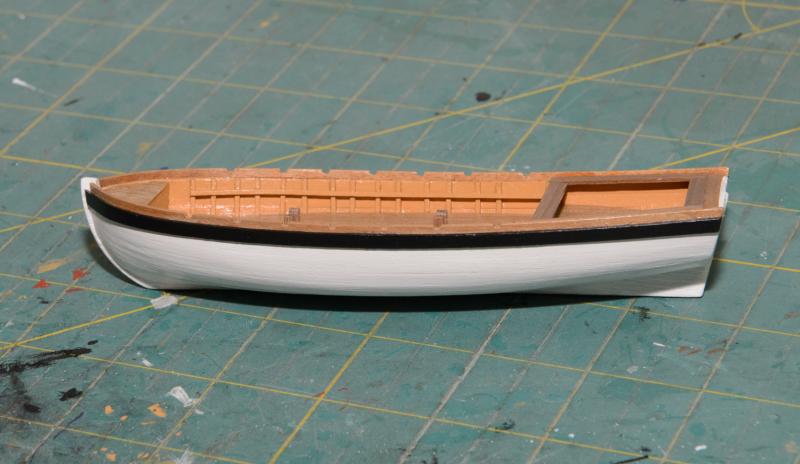
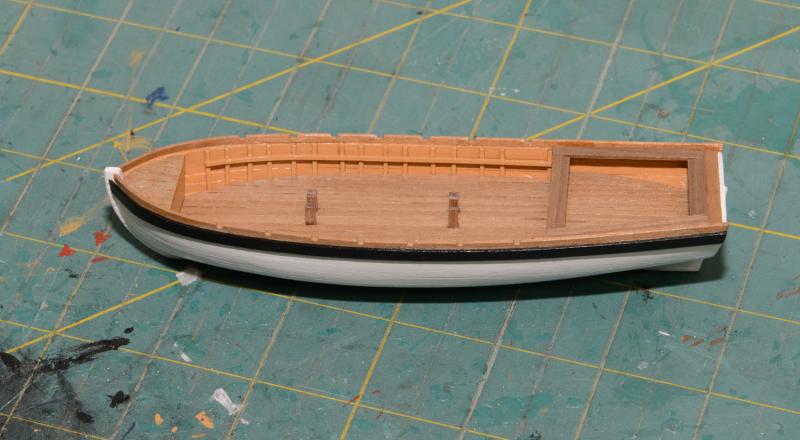
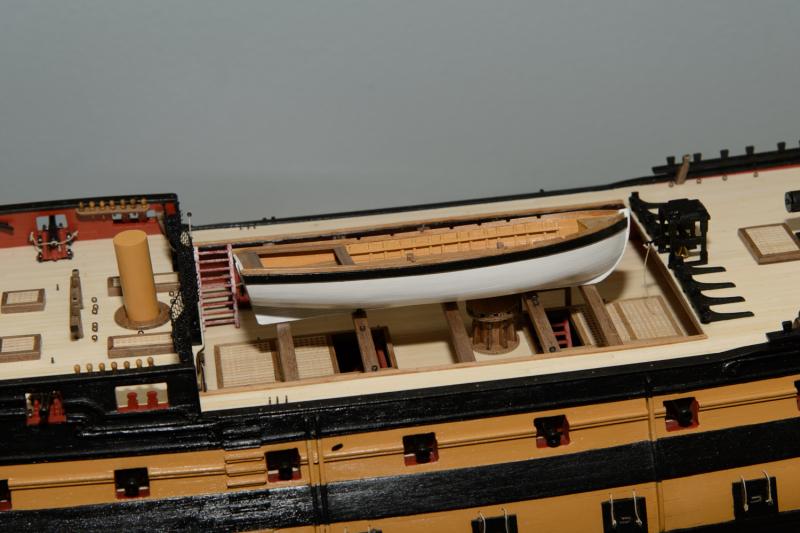
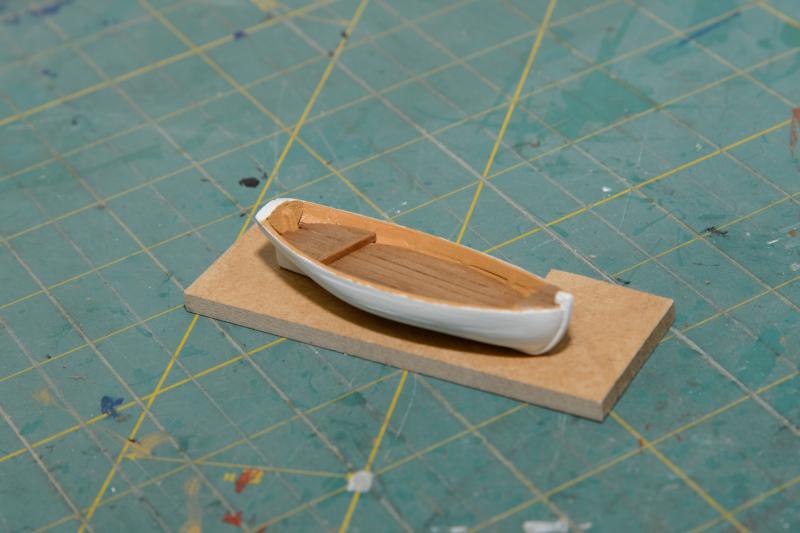
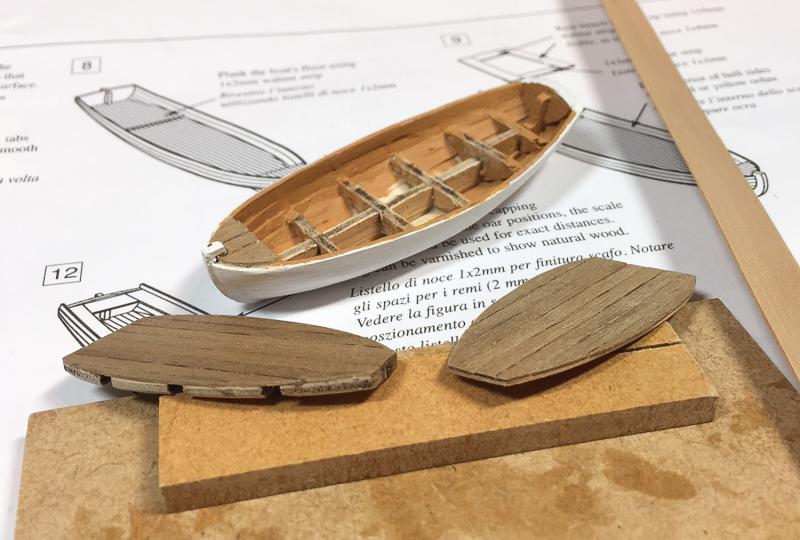
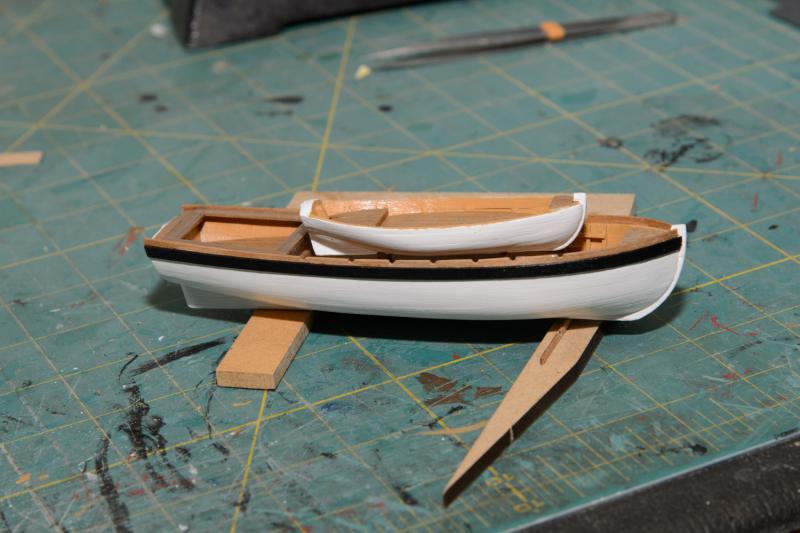

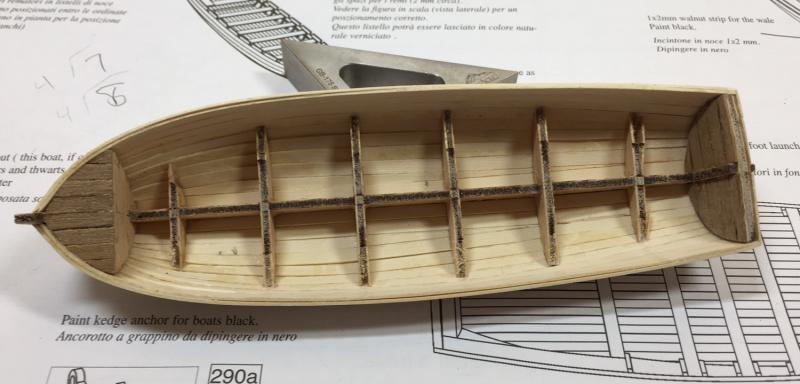
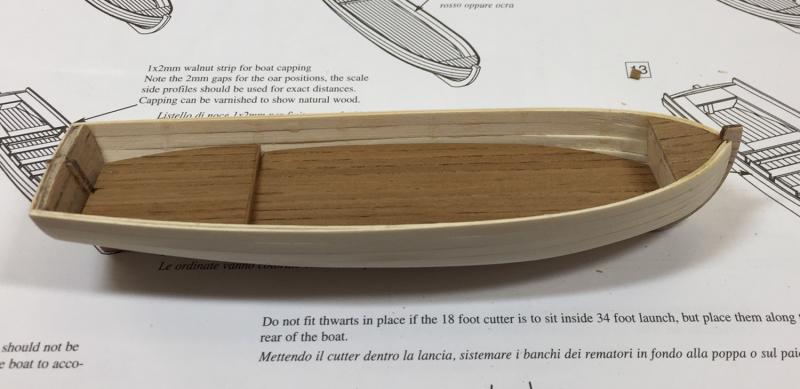
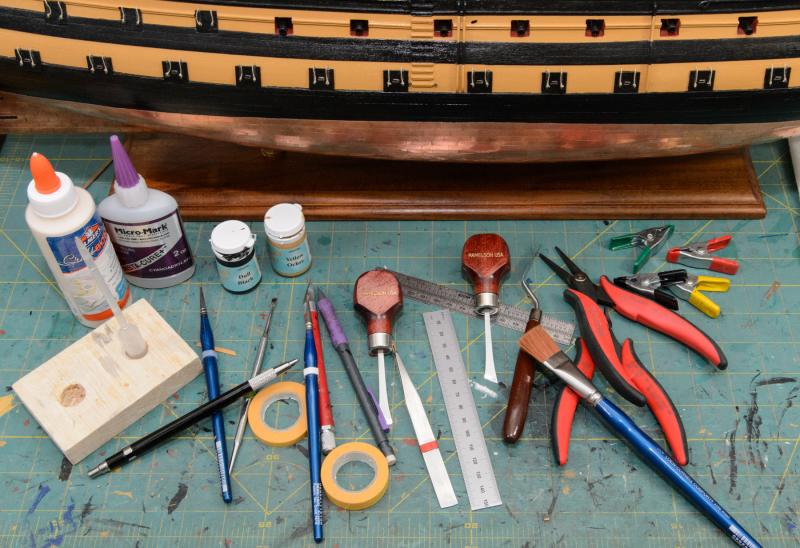
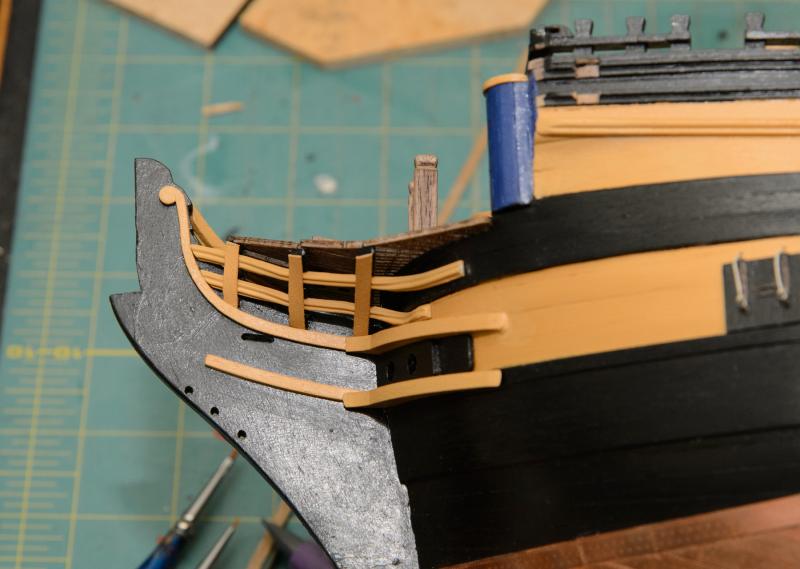
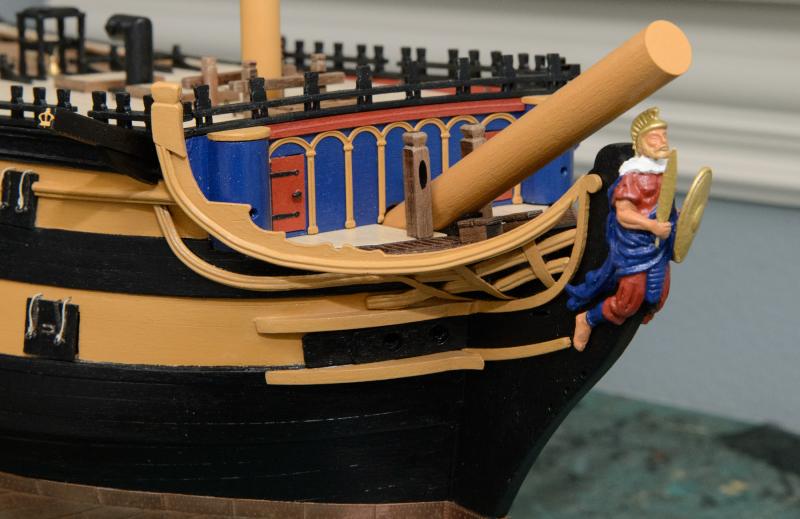
Chris Watton and Vanguard Models news and updates
in Traders, Dealers, Buying or Selling anything? - Discuss New Products and Ship Model Goodies here as well!!
Posted
I once made a silly little stick figure in the right scale for Pegasus. Of course I didn’t leave it on the model, but it was fun. I can’t imagine how crowded a fully manned frigate must have been. That said, I agree Chris’ business is models, not figurines.